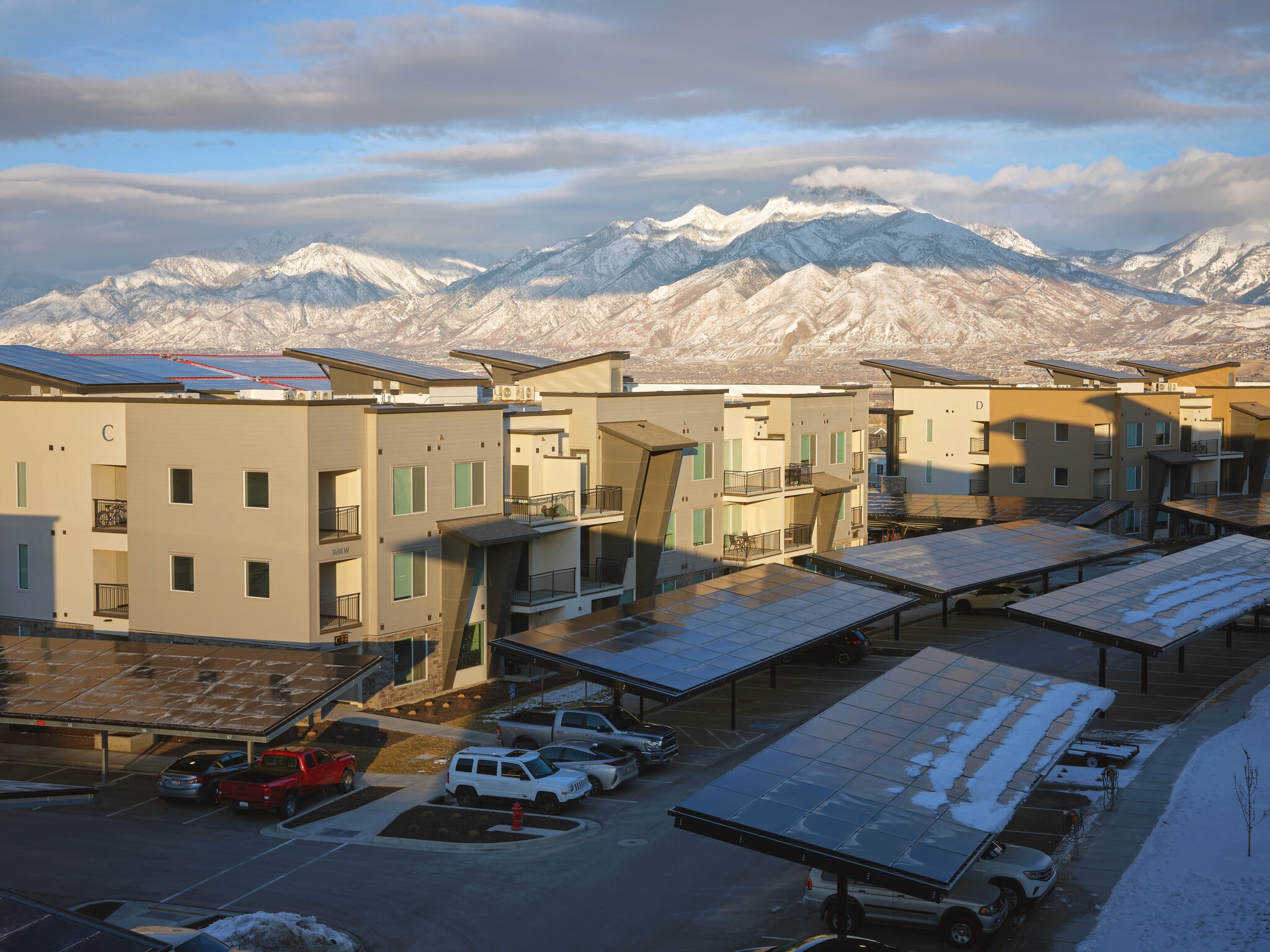The battery cells are charged by rooftop solar panels to form a network that provides the entire building with back-up power for power-up during peak hours

An ecoLinx battery at Soleil Lofts in the suburbs of Salt Lake City. The developed battery cells together form the so-called. "Virtual powerhouse"
Construction firm Soleil Lofts, which is building apartments in the suburbs of Salt Lake City, lures potential buyers into them with various amenities: there are swimming pools, three spas, a basketball court, household appliances, and a place for walking dogs.
However, what attracted Mike Kannenberg, a sales manager at a local tech company, was something else - a quiet battery pack in a beautiful case.
The Kannenberg apartments, like all the other 600 residential units in this $ 156 million complex, are equipped with a new ecoLinx rechargeable battery manufactured by the German company Sonnen. These batteries are about the size of a water heater and are charged by solar panels installed on the roof, and together form the so-called. "Virtual power plant". This system not only provides 12.6 MWh of standby energy to the entire building, but also facilitates the use of renewable energy obtained directly on site.
As 38-year-old Kannenberg said, "If I can do my little bit to improve the world and cleanse Utah, I will gladly."
Advances in battery and solar panel technology, along with companies' drive to expand the use of renewable energy, have made virtual power plants a valuable addition to commercial and residential environments. It is also helped by increased demand for more reliable power systems, fueled by the recent grid failure in Texas and continuous power outages in California , which are trying to mitigate the damage from recurring fires.
Batteries will come in handy in buildings of all kinds, including university and corporate campuses, said K.R. Guerro, vice president of innovation for national construction company Meritage Homes.
“In the 80s, people used to install solar panels because they wanted to do something good,” he said. “Today, installing solar and battery systems like Soleil’s is tantamount to having a $ 20 a month ATM in your kitchen.”
More and more drivers are switching to electric vehicles, and property owners are increasingly realizing the value of generating and storing energy locally - especially in a location where dozens of electric vehicles may need to be charged at the same time.
Many companies, especially from the energy sector, see the potential of virtual power plants. California-based startup OhmConnect plans to build a large-scale system of this kind, receiving $ 100 million from Sidewalk Infrastructure Partners (including Alphabet, Google's parent company). Los Angeles-based Swell Energy has received $ 450 million to build a home virtual power plant that helps power the grid.
In Utah, Soleil Lofts signed the first such agreement with Rocky Mountain Power, which allows it to connect to the battery network as a power source. The agreement allows the system to save on the cost of power generation, and for developers - on the cost of its implementation. So says the management company of the apartments Wasatch Group.
Wasatch directors see virtual power plants as proof that batteries are a smart investment for property owners.
“The virtual powerhouse provides ongoing income and increases the attractiveness of apartments for tenants,” said Ryan Peterson, president of Wasatch Guaranty Capital, a real estate and investment firm. "One of the reasons we are turning to renewable and solar energy is that it reduces operating costs and improves cash flow, which is very important for property owners."
The Soleil project is focusing on several trends: the transition to cleaner and renewable energy, the rapidly falling cost of batteries and energy storage, and the efforts of developers to reduce their environmental impact. According to the Boston Consulting Group, the cost of energy storage has dropped 80% over the past 10 years .
Energy storage in the US has grown significantly over the past year. According to the US Energy Storage Monitor, 476 MWh were added in the third quarter, up 240% from the previous quarter.
However, the situation is still far from a fully renewable energy system. A report from the University of California at Berkeley examining the transition to renewable energy suggests that the United States will need 150 GWh of storage by 2035 to bring the grid's clean energy content to 90%.
“We've reached a turning point,” said Mark Dyson, a clean energy expert at RMI, a Colorado-based renewable energy organization. “Since prices have dropped so much, especially for batteries, I expect that an increasing percentage of new homes will use these technologies. Virtual Power Plants are the cheapest and most valuable upgrade to the US power grid. ”
The electricity consumption of buildings fluctuates throughout the day. Renewable energy sources and batteries can smooth out these cycles by conserving energy at minimal loads and connecting to storage during periods of heavy load. This should reduce the cost of electricity.
“Buildings that use energy efficiently, produce renewable energy and store energy ready to use when needed, has great value,” Guerro said.

Solar energy stored at Soleil Lofts is stored in batteries that can be connected to the local energy provider, Rocky Mountain Power.
Meritage has seven demonstration projects across the country, specifically in Arizona, California, North Carolina and Texas. The company is trying to figure out how to better optimize the grid and reduce energy costs. Guerro believes that more asset management companies will soon be taking advantage of this “load-shifting” system.
For Wasatch, Soleil Lofts offers both financial and marketing benefits. Potential tenants will be attracted by the green energy of the complex, and in the future the cost of energy in it will be lower. Rechargeable batteries outperform conventional buildings in terms of energy costs, Peterson said.
Wasatch began researching renewable energy years ago, trying to lower prices across its 20,000-unit apartment complexes as well as offices, hotels and industrial plants. There were no savings from solar panels alone, so four years ago the company began to study the work of a combination of panels and batteries. Wasatch made Soleil a test case, and partnered with Rocky Mountain Power and Sonnen to address the challenges of virtual power plants.
The apartment was partially operational last fall, and since then, according to Peterson, the energy storage project has met all expectations. The $ 34 million battery system, of which $ 3.3 was covered by grants from Rocky Mountain Power, sells energy back to the utility to cover peak periods. Peterson says residents are saving 30-40% on electricity costs by doing this.
Projects like these are becoming real-time energy sources, says William Comeu, vice president of user experience and innovation at PacifiCorp, the parent company of Rocky Mountain Power. To reach 60% renewable energy by 2030, Rocky Mountain Power needs to invest heavily in storage systems as well as small distribution centers like Soleil. He said that falling battery prices would open up more room for expansion.
Other developers are also organizing battery storage facilities in conjunction with utilities. Related Companies installed 4.8 MWh batteries at Gateway Center in Brooklyn in an area that no one would use anyway. It is now an energy storage facility operated by energy company Enel X. The
companies declined to disclose lease details, but Related VP Luke Folk said a similar battery storage system could help his company and others like it make money and meet green energy goals. ...

Solar heated pool at Soleil Lofts.

Other amenities include chargers for electric vehicles.
Soleil's pioneering approach has shown that projects like these can work, but are not easy to replicate. Comu said there are technical challenges associated with this, and it is often necessary for owners to have similar experience to be successful. He predicts that as other energy companies increase the percentage of renewable energy, there will be more such partnerships.
“And new customers will no longer have to go through all the steps that Wasatch went through from scratch,” - said Comu.
Wasatch plans to expand the Soleil model. Six pilot programs are already being prepared and will be implemented in existing properties in California. Their goal is to find out if other buildings can achieve the same efficiency and cost savings. Peterson wants to end up with some kind of turnkey solution that will equip other virtual power plant owners' properties.
“We believe that it is possible, and as soon as we can prove it, this model will open up much broader prospects,” he said.